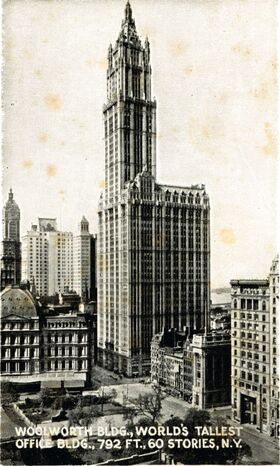Category:Woolworths
Until it went bust in 2009, the chain store Woolworths was a fixture on pretty much every British high street, selling a slightly random-looking selection of household goods, mixed in with toys, pick-and-mix sweets, childrens clothes, and anything else that the company thought might appeal to shoppers on tight budgets. In December, the stores would be full of customers clutching dog-eared paper lists, trying to see whether they could manage to buy all their Christmas presents in one place, without having to go traipsing around the rest of the high street.
1879: creation, USA
~1923: The Woolworth Building, "The World's Tallest Office Building", New York [image info]
The F. W. Woolworth Company opened its first shop in Pennsylvania, USA in 1879, and became a huge success.
1909: UK offshoot, creation and expansion
After establishing his chain in the US, Frank Woolworth set his sights on England. Frank had traced his lineage back to England and become fixated on the idea of conquering the British market, to the alarm of some of his US managers, who seemed to think that their boss had "lost the plot". After sailing to Liverpool on a buying trip, Frank became more determined to make the idea of a British chain a reality, and opened the first British shop in Liverpool in 1909.
By 1914, this had grown to 40 stores, and in the early 1920s, the offshoot company embarked on an agressive programme of expansion, entirely paid for out of local profits. It opened its 400th branch in 1930, and was then relaunched as a company listed on the stock exchange, which raised further funds and allowed the number of stores to expand to 600 in 1934, 800 in 1953, and 1000 in 1958.
Woolworths Group ceased trading and entered administration in 2008/2009, and was formally dissolved in 2015.
Woolworths and toys
The existence of Woolworths made a large impact on the UK toy market, as Woolworths' buying power meant that, if Woolworths decided that a type of toy could sell, and could find a manufacturer prepared to get the price sufficiently low, they could order very large quantities of a product line.
The early Trix construction sets (which were designed to have parts that were more multi-function, allowing sets to have a smaller number of parts, and therefore be cheaper) sold through Woolworths, as did some of the earliest Airfix kits, and the earliest Rovex train sets (later to become Tri-ang Railways). Participating with Woolworths allowed a small company to get a guaranteed cash injection and orders ... provided that one did not price things so low as to lose money. However, if a new toy company became successful, they usually then tried to move away from Woolwrths and sell through "proper" toy shops that would let them do more to promote their own brand, and to sell at a higher price point.
Toys that continued to sell through the chain tended to be only weakly branded, or completely anonymous (eg plastic buckets and spades, and beach balls), and when a UK toy brand would not always put their names onto their toys, it was often so that these lines could be sold "as-is" as part fo another brand's line, or through an outlet like "Woollies".
External links
Media in category ‘Woolworths’
This category contains only the following file.
- Woolworth Building, New York (Bardell 1923).jpg 1,802 × 3,000; 1.2 MB




